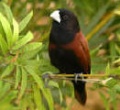LOG IN. UPLOAD PICTURES.
The Philippines has Zambo Mart to help propagate the Chavacano Language.
Difference between revisions of "Birds"
(→Maya) |
|||
| Line 3: | Line 3: | ||
<!-- Don not edit above this line --> | <!-- Don not edit above this line --> | ||
==Maya== | ==[[:Category:Maya (bird)|Maya]]== | ||
Most farmers see the little birds as pests, though it is more the farmer and the kainginero, and not the bird, who are invaders in the Maya’s traditional habitats with their plantations and kaingins. It is nature’s way of cutting man down to size that the Mayas periodically raid the ripening fields of rice grains that farmers and kaingineros impertinently sow in lands that are rightfully the domain of the little birds. Sounds familiar? Hmmmm.... [[Maya|Read On]] | Most farmers see the little birds as pests, though it is more the farmer and the kainginero, and not the bird, who are invaders in the Maya’s traditional habitats with their plantations and kaingins. It is nature’s way of cutting man down to size that the Mayas periodically raid the ripening fields of rice grains that farmers and kaingineros impertinently sow in lands that are rightfully the domain of the little birds. Sounds familiar? Hmmmm.... [[Maya|Read On]] | ||
<gallery> | <gallery> | ||
Revision as of 03:29, 5 April 2015
Birds, classified as Aves, are warm-blooded, feathered creatures with two legs and wings. They lay hard-shelled eggs and possess unique characteristics such as a beak without teeth, a high metabolic rate, a four-chambered heart, and a lightweight yet robust skeleton. While most bird species have developed wings and the ability to fly, there are flightless birds like ratites, penguins, and certain species found on isolated islands. Some birds, such as penguins and certain ducks, have adapted for swimming. Birds have specialized digestive and respiratory systems tailored for flight. Certain species, including corvids and parrots, exhibit remarkable intelligence, tool usage, and cultural transmission of knowledge across generations.
Many bird species undertake extensive migrations annually. Birds are social creatures, communicating through visual signals, calls, and songs. They engage in cooperative behaviors like breeding, hunting, flocking, and mobbing predators. The majority of bird species are socially monogamous, typically forming pairs for one breeding season or longer, though lifelong monogamy is rare. Other species exhibit polygynous or polyandrous breeding systems. Birds lay their eggs in nests and provide extended parental care after hatching.
With approximately ten thousand living species, Aves stands as the tetrapod class with the greatest diversity. Birds inhabit diverse habitats worldwide, ranging in size from the tiny bee hummingbird (5 cm or 2 in) to the towering ostrich (2.75 m or 9 ft). Fossil evidence suggests that true birds emerged during the Cretaceous period, around 100 million years ago. The scientific consensus supports the notion that birds are descendants of theropod dinosaurs.
Birds hold significant economic importance. Domesticated and wild birds, such as poultry and game, serve as valuable sources of eggs, meat, and feathers. Many people keep songbirds, parrots, and other bird species as pets. Guano, the excrement of birds, is harvested for its use as a fertilizer. Birds also hold cultural significance and have been represented in various human traditions and arts. Unfortunately, human activities have led to the extinction of numerous bird species, with many more currently at risk. Conservation efforts are underway to protect endangered bird species. Birdwatching is a popular recreational activity and an important component of ecotourism.
|
|
Back to Flora and Fauna
for the birds and animals
Maya
Most farmers see the little birds as pests, though it is more the farmer and the kainginero, and not the bird, who are invaders in the Maya’s traditional habitats with their plantations and kaingins. It is nature’s way of cutting man down to size that the Mayas periodically raid the ripening fields of rice grains that farmers and kaingineros impertinently sow in lands that are rightfully the domain of the little birds. Sounds familiar? Hmmmm.... Read On
The Philippine Monkey-Eating Eagle
The Philippine Monkey eating Eagle was named the national bird of the Philippines in 1995.
The Monkey-eating Eagle, Pithecophaga jefferyi, is a fine forest eagle of the Philippines. It has remarkably strong legs and an extremely deep and compressed bill. It is about 3 feet tall with a 6-1/2 foot wingspan. It weighs about 14 pounds. The average life expectancy is anywhere from 30 to 60 years.
.
Short-toed Eagle
National Bird of Spain: Short-toed Eagle (Circaetus gallicus)
.






